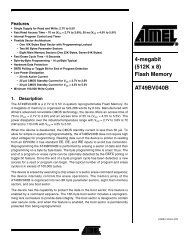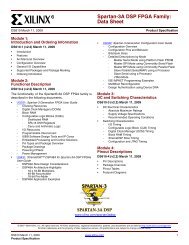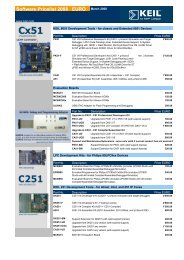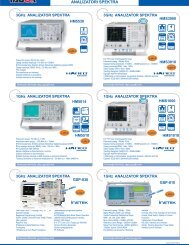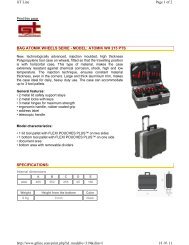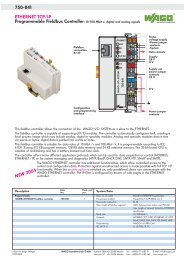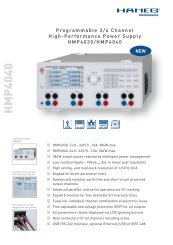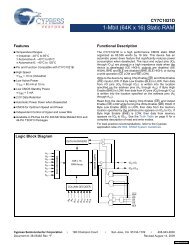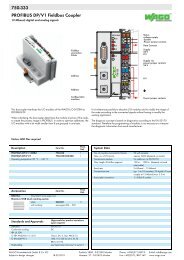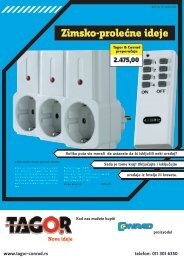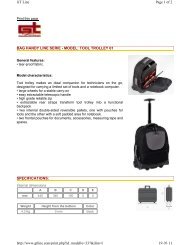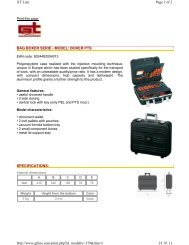PIC12F683 Data Sheet - Microchip
PIC12F683 Data Sheet - Microchip
PIC12F683 Data Sheet - Microchip
Create successful ePaper yourself
Turn your PDF publications into a flip-book with our unique Google optimized e-Paper software.
<strong>PIC12F683</strong><br />
3.3 PCL and PCLATH<br />
The Program Counter (PC) is 13 bits wide. The low byte<br />
comes from the PCL register, which is a readable and<br />
writable register. The high byte (PC) is not<br />
directly readable or writable and comes from PCLATH.<br />
On any Reset, the PC is cleared. Figure 3-3 shows the<br />
two situations for the loading of the PC. The upper<br />
example in Figure 3-3 shows how the PC is loaded on a<br />
write to PCL (PCLATH → PCH). The lower example<br />
in Figure 3-3 shows how the PC is loaded during a<br />
CALL or GOTO instruction (PCLATH → PCH).<br />
FIGURE 3-3:<br />
3.3.1 COMPUTED GOTO<br />
LOADING OF PC IN<br />
DIFFERENT SITUATIONS<br />
12 8 7 0<br />
PC<br />
PC<br />
5<br />
PCLATH<br />
PCLATH<br />
12 11 10 8 7<br />
0<br />
2<br />
PCH<br />
PCH<br />
PCLATH<br />
PCLATH<br />
PCL<br />
PCL<br />
Instruction with<br />
PCL as<br />
Destination<br />
ALU Result<br />
GOTO, CALL<br />
OPCODE<br />
A computed GOTO is accomplished by adding an offset<br />
to the program counter (ADDWF PCL). When performing<br />
a table read using a computed GOTO method, care<br />
should be exercised if the table location crosses a PCL<br />
memory boundary (each 256-byte block). Refer to the<br />
Application Note AN556, “Implementing a Table Read”<br />
(DS00556).<br />
11<br />
8<br />
The stack operates as a circular buffer. This means that<br />
after the stack has been PUSHed eight times, the ninth<br />
push overwrites the value that was stored from the first<br />
push. The tenth push overwrites the second push (and<br />
so on).<br />
Note 1: There are no Status bits to indicate stack<br />
overflow or stack underflow conditions.<br />
2: There are no instructions/mnemonics<br />
called PUSH or POP. These are actions<br />
that occur from the execution of the<br />
CALL, RETURN, RETLW and RETFIE<br />
instructions or the vectoring to an<br />
interrupt address.<br />
3.4 Indirect Addressing, INDF and<br />
FSR Registers<br />
The INDF register is not a physical register. Addressing<br />
the INDF register will cause indirect addressing.<br />
Indirect addressing is possible by using the INDF<br />
register. Any instruction using the INDF register<br />
actually accesses data pointed to by the File Select<br />
Register (FSR). Reading INDF itself indirectly will<br />
produce 00h. Writing to the INDF register indirectly<br />
results in a no operation (although Status bits may be<br />
affected). An effective 9-bit address is obtained by<br />
concatenating the 8-bit FSR register and the IRP bit of<br />
the STATUS register, as shown in Figure 3-4.<br />
A simple program to clear RAM location 20h-2Fh using<br />
indirect addressing is shown in Example 3-1.<br />
EXAMPLE 3-1:<br />
INDIRECT ADDRESSING<br />
MOVLW 0x20 ;initialize pointer<br />
MOVWF FSR ;to RAM<br />
NEXT CLRF INDF ;clear INDF register<br />
INCF FSR ;inc pointer<br />
BTFSS FSR,4 ;all done<br />
GOTO NEXT ;no clear next<br />
CONTINUE<br />
;yes continue<br />
3.3.2 STACK<br />
The <strong>PIC12F683</strong> family has an 8-level x 13-bit wide<br />
hardware stack (see Figure 3-1). The stack space is<br />
not part of either program or data space and the Stack<br />
Pointer is not readable or writable. The PC is PUSHed<br />
onto the stack when a CALL instruction is executed or<br />
an interrupt causes a branch. The stack is POPed in<br />
the event of a RETURN, RETLW or a RETFIE instruction<br />
execution. PCLATH is not affected by a PUSH or POP<br />
operation.<br />
© 2007 <strong>Microchip</strong> Technology Inc. DS41211D-page 17



